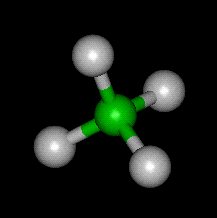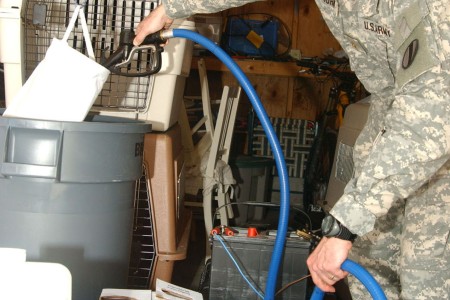 Last month, a man at a bar introduced himself as "Coyote," and told me he was working on the Pentagon's plans to build a string of satellites that beamed solar rays down to Earth.
Last month, a man at a bar introduced himself as "Coyote," and told me he was working on the Pentagon's plans to build a string of satellites that beamed solar rays down to Earth.
Showing posts with label Alternative Fuels. Show all posts
Showing posts with label Alternative Fuels. Show all posts
Sunday, 24 June 2007
Military Target: Solar-Beaming Sats
 Last month, a man at a bar introduced himself as "Coyote," and told me he was working on the Pentagon's plans to build a string of satellites that beamed solar rays down to Earth.
Last month, a man at a bar introduced himself as "Coyote," and told me he was working on the Pentagon's plans to build a string of satellites that beamed solar rays down to Earth.Wireless energy promise powers up
 A clean-cut vision of a future freed from the rat's nest of cables needed to power today's electronic gadgets has come one step closer to reality.
A clean-cut vision of a future freed from the rat's nest of cables needed to power today's electronic gadgets has come one step closer to reality.US researchers have successfully tested an experimental system to deliver power to devices without the need for wires.
Friday, 22 June 2007
Potatoes: The Next Plastic?
 The usual choices for potatoes include baked, mashed or french fried, but a new study suggests another option: plastic.
The usual choices for potatoes include baked, mashed or french fried, but a new study suggests another option: plastic.A report by the University of Maine's Margaret Chase Smith Policy Center says the state's potato industry could benefit by becoming a producer of bioplastics, which are made from plant starch rather than crude oil and petroleum products.
Read More
Monday, 11 June 2007
New fuel for 21st century -- aluminum pellets?
 Pellets made out of aluminum and gallium can produce pure hydrogen when water is poured on them, offering a possible alternative to gasoline-powered engines, U.S. scientists say.
Pellets made out of aluminum and gallium can produce pure hydrogen when water is poured on them, offering a possible alternative to gasoline-powered engines, U.S. scientists say.Hydrogen is seen as the ultimate in clean fuels, especially for powering cars, because it emits only water when burned. U.S. President George W. Bush has proclaimed hydrogen to be the fuel of the future, but researchers have not yet found the most efficient way to produce and store hydrogen.
Monday, 28 May 2007
Methane to Power Rockets of Future?
 The trouble with exploring the solar system is that there just aren't any rocket fueling stations out there. That won't be the case if future planet-hopping astronauts are equipped with a new kind of rocket engine which burns two gases that are already in good supply on several other planets: methane and oxygen.
The trouble with exploring the solar system is that there just aren't any rocket fueling stations out there. That won't be the case if future planet-hopping astronauts are equipped with a new kind of rocket engine which burns two gases that are already in good supply on several other planets: methane and oxygen.Methane doesn't exactly have high-tech, Trekkie credentials, being better known for its association with flatulent cows and natural gas. But the latest tests of a prototype supersonic methane rocket engine by XCOR Aerospace show that the good old swamp gas has interplanetary potential.
Thursday, 24 May 2007
UK publishes report on environmental benefits of nanotechnology

(Nanowerk News) The "Environmentally Beneficial Nanotechnologies: Barriers and Opportunities" (pdf download, 748 KB), a new report by the UK's Department for Environment, Food and Rural Affairs (Defra), was published today.
Under this study, five nanotechnological applications were subject to detailed investigation: fuel additives, photovoltaics (solar cells), the hydrogen economy, electricity storage and insulation. In these areas nanotechnology could contribute to reducing greenhouse gas emissions by up to 2 % in the near term and up to 20 % by 2050 with similar reductions in air pollution being realised.
Overview of the report’s investigations into the nanotechnology focus areas:
Fuel additives: Nanoparticle additives have been shown to increase the fuel efficiency of diesel engines by approximately 5% which could result in a saving of 2-3 million tonnes of CO2 in the UK. This could be implemented immediately across the UK diesel powered fleet. However, this must be tempered by concerns about the health impact of free nanoparticles in diesel exhaust gases. Recommendations include: Comprehensive toxicological testing and subsidised independent performance tests to validate environmental benefit.
Solar cells: The high prices of solar cells are inhibiting their installation into distributed power generation, reducing energy generation from renewables. Nanotechnology may deliver more benefits in significantly decreasing the cost of production of solar cells. Conservatively, if a distributed solar generation grid met 1% of our electricity demand, approximately 1.5 million tonnes of CO2 per annum could be saved. The major barrier to this technology is the incorporation of the nanotechnology into the solar cell, not the nanotechnology itself. The UK is one of the world leaders in understanding the fundamental physics of solar cells, but we lack the skills that allow us to transfer our science base into workable prototypes. Recommendations include: Develop programs and facilities for taking fundamental research through to early stage prototypes where established mechanisms can be employed to commercialise new technologies. Set up a centre of excellence in photovoltaics which allows cross fertilisation of ideas from different scientific disciplines.
The hydrogen economy: Hydrogen powered vehicles could eliminate all noxious emissions from road transport, which would improve public health. If the hydrogen is generated via renewable means or using carbon capture and storage, all CO2 emissions from transport could be eliminated (132 million tonnes). Using current methods of hydrogen generation, significant savings in carbon dioxide (79 Mte) can be made. The technology is estimated to be 40 years away from universal deployment. The UK is becoming one of the front runners in this area. Although we do not have a substantial automotive R&D base, the international nature of these companies will allow ready integration of UK innovation into transport. Recommendations include: The use of public procurement to fund hydrogen powered buses in major cities to create a market and infrastructure for hydrogen powered transport. Continue to fund large demonstration projects and continue R&D support.
Batteries and supercapacitors: Recent advances in battery technology have made the range and power of electric vehicles more practical. Issues still surround the charge time. Nanotechnology may provide a remedy to this problem allowing electric vehicles to be recharged in less than ten minutes, which is comparable to the refuelling time of current cars. If low carbon electricity generation techniques are used, CO2 from private transport could be eliminated (64 Mte) or, using the current energy mix, savings of 42 Mte of carbon dioxide could be made. Without nanotechnology, electric vehicles are likely to remain niche due to the issues of charge time. Significant infrastructural investment will be required to develop recharging stations throughout the UK. Recommendations include: Fast track schemes for commercialisation and cultivate links with automotive multinationals.
Insulation: Cavity and loft insulation are cheap and effective, however, there are no easy methods for insulating solid walled buildings, which currently make up approximately one third of the UK’s housing stock. Nanotechnology may provide a solution which, if an effective insulation could be found with similar properties to standard cavity insulation, could result in emission reductions equivalent to 3 Mte per year. Ultra thin films on windows to reduce heat loss already exist on the market. Recommendations include: Fund a DTI technology program call on novel insulation material for solid walled buildings and retrofit government offices with highly insulating nanotechnology based windows.
An appendix to the report can be downloaded here (pdf, 638 KB).
Source: Defra
Source: Defra
Sunday, 22 April 2007
Sun converts carbon dioxide into fuel
 We all know that the increasing concentration of carbon dioxide in the atmosphere has a major impact on the Earth climate. But now, chemists at the University of California at San Diego (UCSD) have developed "a device that can capture energy from the sun, convert it to electrical energy and split carbon dioxide into carbon monoxide and oxygen."
We all know that the increasing concentration of carbon dioxide in the atmosphere has a major impact on the Earth climate. But now, chemists at the University of California at San Diego (UCSD) have developed "a device that can capture energy from the sun, convert it to electrical energy and split carbon dioxide into carbon monoxide and oxygen."As carbon monoxide can easily be converted to liquid fuel, this prototype device kills two birds with one stone: it helps saving fuel while reducing the concentration of a greenhouse gas. Still, this device needs some improvements before an industrial deployment.
Read More
Thursday, 19 April 2007
Ethanol may cause more smog, more deaths
 WASHINGTON - Switching from gasoline to ethanol — touted as a green alternative at the pump — may create dirtier air, causing slightly more smog-related deaths, a new study says.
WASHINGTON - Switching from gasoline to ethanol — touted as a green alternative at the pump — may create dirtier air, causing slightly more smog-related deaths, a new study says.Nearly 200 more people would die yearly from respiratory problems if all vehicles in the United States ran on a mostly ethanol fuel blend by 2020, the research concludes. Of course, the study author acknowledges that such a quick and monumental shift to plant-based fuels is next to impossible.
Read More
Wednesday, 18 April 2007
New partnership to produce diesel fuel from animal fat
 By Clifford Krauss The New York TimesTuesday, April 17, 2007
By Clifford Krauss The New York TimesTuesday, April 17, 2007Tyson Foods and ConocoPhillips have cooked up a new recipe for your pickup truck.
The two companies announced Monday that they were forming an alliance to produce and market diesel fuel made from pork, poultry and beef fat.
This was another sign that farmers and agribusinesses, which are now producing corn for ethanol, would be playing an increasingly large part in the country's energy future. The new brew should be available at the neighborhood filling station by the end of the year.
Corn Can’t Solve Our Problem
Sunday, 15 April 2007
TRADOC Soldier Cruises with Cooking Oil

FORT MONROE, Va. (Army News Service, April 11, 2007) - Drooling over a tricked-out truck isn't unusual for many American males.But salivary glands spring into action for an entirely different reason when a particular Dodge pickup drives around this post ... it emits the yummy smell of fried food.Its fuel is cooking oil.The blue and white truck, which belches out food fragrances instead of noxious fumes, is owned by Maj. Bradley Bourn, plans analyst for the Deputy Chief of Staff for Operations and Training, U.S. Army Training and Doctrine Command.
Saturday, 14 April 2007
A Better Biofuel
A California biotech company is engineering microbes to produce cheap biofuels that could outcompete ethanol.
Subscribe to:
Posts (Atom)
